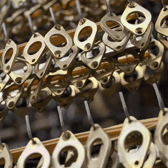The Gold Standard in Metal Preservation: Understanding Zinc Plating’s Prowess
In terms of metal protection, one method stands above the rest zinc plating. It is a process used to coat metal surfaces with a thin layer of zinc. This involves immersing a metal object in a zinc ions solution and applying an electric current. It is widely employed in various industries to enhance the corrosion resistance of metals, such as steel and iron.
Join us as we explore zinc platings rich origins and key characteristics, highlighting its unrivaled excellence in diverse sectors.
Origins and Evolution of Zinc Plating
During the 19th century, using electrical currents to deposit metal onto conductive surfaces laid the foundation for various electroplating methods, including zinc plating. This technique was utilized to prevent corrosion on iron and steel. Its unique characteristics have led to widespread adoption in industries such as shipbuilding and early automotive manufacturing.
The surge in manufacturing activities and the demand for durable, corrosion-resistant materials during the Industrial Revolution prompted further innovations in electroplating processes. Zinc plating became integral to mass production, offering a practical solution to enhance the longevity of various metal components.
As the 20th century unfolded, technological advancements in materials science and electrochemistry significantly contributed to the evolution of zinc plating. The industry witnessed innovations in plating bath formulations, the introduction of automated plating processes, and the development of more environmentally friendly practices.
In the present day, zinc plating has evolved into a versatile and indispensable technique across numerous industries. Its applications extend beyond traditional uses, with zinc-plated components found in electronic devices, construction materials, and more. In addition, the contemporary emphasis on sustainability has also influenced the evolution of this metal coating method. Modern processes strive to minimize environmental impact, aligning with global awareness of eco-friendly manufacturing practices.
Why Zinc Plating Is Widely Used in Various Industries
Zinc plating offers key characteristics that make it a preferred choice in various industries. Here are its defining features:
Corrosion Resistance
One of the primary benefits of zinc plating is its rust-resistant properties. The zinc coating acts as a sacrificial layer, corroding first to protect the underlying metal from oxidation and rust.
Versatility
Zinc plating protects various metal substrates, such as steel, iron, and aluminum. It finds applications in diverse industries, including automotive, construction, electronics, and hardware.
Cost-Effectiveness
Zinc is an abundant and relatively inexpensive metal. The cost-effectiveness of this metal coating method makes it an attractive option for large-scale manufacturing processes.
Aesthetics
Zinc plating can enhance the appearance of metal surfaces, providing a shiny and aesthetically pleasing finish. This makes it valuable for corrosion protection and improving the overall look of coated components.
Durability
The electroplated zinc layer tightly adheres to the metal substrate, ensuring durability and long-lasting protection. This adhesion is crucial for the effectiveness of the coating, especially in applications with high wear and tear.
Ease of Application
The zinc plating process is relatively straightforward, involving immersion of the metal object in a zinc solution and the application of an electric current. This simplicity contributes to its widespread use in various industrial settings.
Environmental Considerations
Zinc plating tends to have a lower environmental impact than alternative coatings. Modern processes focus on minimizing waste and optimizing resource use, aligning with growing concerns about sustainability.
Compatibility
Zinc plating can be easily combined with other finishes and coatings to achieve desired properties. This adaptability makes it suitable for various manufacturing requirements.
Electrochemical Properties
Zinc being more reactive than many base metals provides effective cathodic protection. It helps prevent the development of corrosion by serving as a sacrificial anode.
Get Top-Notch Metal Finishing From New Method Plating
At New Method Plating, we have upheld a strong commitment to quality and have taken immense pride in our craftsmanship since 1931. As an industry leader in zinc electroplating services, our dedication is reflected in our industry-standard certifications, including ISO 9001:2015, AS9100, Nadcap AS7108. Our products also comply with military standards like ASTM B633, AMS 2402, MIL-STD-171, ASTM F1914, ISO 4042. In addition, we continually upgrade our facilities and equipment to maintain our position as one of the finest specialty platers in the New England region.
Contact us for more information on our products and services, or request a quote today to experience metal finishing that exceeds expectations!





